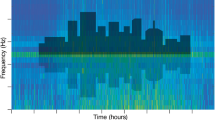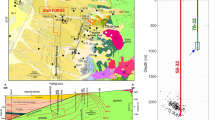Abstract
Public concern about oil and gas (O&G) operations in residential areas is substantial. Noise from construction and drilling related to O&G operations may be greater than other phases of O&G operations; yet the impacts of audible and low-frequency noise during these operations are not extensively explored nor the effects on health well understood. This study documents the noise levels at a multi-well O&G well pad during construction and drilling in a residential area in Colorado. A-weighted (dBA) and C-weighted (dBC) noise measurements were collected at four locations during development over a 3-month period. The maximum 1-min equivalent continuous sound levels over a 1-month period were 60.2 dBA and 80.0 dBC. Overall, 41.1% of daytime and 23.6% of nighttime dBA 1-min equivalent continuous noise measurements were found to exceed 50 dBA, and 97.5% of daytime and 98.3% of nighttime measurements were found to exceed 60 dBC. Noise levels exceeding 50 dBA or 60 dBC may cause annoyance and be detrimental to health; thus, these noise levels have the potential to impact health and noise levels and associated health effects warrant further investigation.
This is a preview of subscription content, access via your institution
Access options
Subscribe to this journal
Receive 6 print issues and online access
$259.00 per year
only $43.17 per issue
Buy this article
- Purchase on Springer Link
- Instant access to full article PDF
Prices may be subject to local taxes which are calculated during checkout



Similar content being viewed by others
Notes
The exact location of noise sampling is not shown to protect the identity of the property owners.
References
Adgate JL, Goldstein BD, McKenzie LM. Potential public health hazards, exposures and health effects from unconventional natural gas development. Environ Sci Technol. 2014;48:8307–20.
McKenzie LM, Allshouse WB, Burke T, Blair BD, Adgate JL. Population size, growth, and environmental justice near oil and gas wells in Colorado. Environ Sci Technol. 2016;50:11471–80.
Haley M, McCawley M, Epstein AC, Arrington B, Bjerke EF. Adequacy of current state setbacks for directional high-volume hydraulic fracturing in the Marcellus, Barnett, and Niobrara Shale Plays. Environ Health Perspect. 2016. https://doi.org/10.1289/ehp.1510547.
Hays J, Mccawley M, Shonkoff SBC. Science of the total environment public health implications of environmental noise associated with unconventional oil and gas development. Sci Total Environ. 2017;580:448–56.
McKenzie LM, Witter RZ, Newman LS, Adgate JL. Human health risk assessment of air emissions from development of unconventional natural gas resources. Sci Total Environ. 2012;424:79–87.
Mckenzie LM, Guo R, Witter RZ, Savitz DA, Newman LS, Adgate JL. Birth outcomes and maternal residential proximity to natural gas development in rural Colorado. Environ Health Perspect. 2014;122:412–7.
Casey JA, Savitz DA, Rasmussen SG, Ogburn EL, Pollak J, Mercer DG, Schwartz BS. Unconventional natural gas development and birth outcomes in Pennsylvania, USA. Epidemiology. 2017;27:163–72.
Blair BD, McKenzie LM, Allshouse WB, Adgate JL. Is reporting ‘significant damage’ transparent? Assessing fire and explosion risk at oil and gas operations in the United States. Energy Res Soc Sci. 2017; 29. https://doi.org/10.1016/j.erss.2017.04.014.
Tustin AW, Hirsch AG, Rasmussen SG, Casey JA, Bandeen-roche K, Schwartz BS. Associations between unconventional natural gas development and nasal and sinus, migraine headache, fatigue symptoms in Pennsylvania. Environmental Health Perspectives. 2016. doi:10.1289/EHP281.
Rasmussen SG, Ogburn EL, Mccormack M, Casey JA, Bandeen-Roche K, Mercer DG. et al. Association between unconventional natural gas development in the Marcellus Shale and asthma exacerbations. JAMA Internal Medicine. 2016;21205:1–10.
Weinberger B, Greiner LH, Walleigh L, Brown D. Health symptoms in residents living near shale gas activity: a retrospective record review from the environmental health project. Prev Med Rep. 2017. https://doi.org/10.1016/j.pmedr.2017.09.002.
Witter RZ, McKenzie L, Stinson KE, Scott K, Newman LS, Adgate J. The use of health impact assessment for a community undergoing natural gas development. 2013. http://ajph.aphapublications.org/doi/abs/10.2105/AJPH.2012.301017 (accessed 2 Mar 2016).
Boyle MD, Payne-Sturges DC, Sangaramoorthy T, Wilson S. Hazard ranking methodology for assessing health impacts of unconventional natural gas development and production: The Maryland Case Study. PLoS ONE. 2016;11:1–15.
Radtke C, Autenrieth DA, Lipsey T, Brazile WJ. Noise characterization of oil and gas operations. Journal of Occupational and Environmental Hygiene. 2017;14: 9624. https://doi.org/10.1080/15459624.2017.1316386.
Boyle MD, Soneja S, Lesliam Quiro s-Alcala LD, Sapkota AR, Thurka Sangaramoorthy SW, Milton D et al. A pilot study to assess residential noise exposure near natural gas compressor stations. PLoS ONE. 2017;12:1–15.
Broner N. A simple criterion for low frequency noise emission assessment. Journal of Low Frequency Noise, Vibration and Active Control. 2010;29:1–13.
Ferrar KJ, Kriesky J, Christen CL, Marshall LP, Malone SL, Sharma RK, et al. Assessment and longitudinal analysis of health impacts and stressors perceived to result from unconventional shale gas development in the Marcellus Shale region. Int J Occup Environ Health. 2013;19:104–12.
Opsal T, Connor TO. Energy crime, harm, and problematic state response in Colorado: a case of the fox guarding the hen house? Critical Criminology. 2014;22:561–77.
Hoffman R. COGCC aims to address noise issues. Wind Now. 2016. http://www.mywindsornow.com/news/cogcc-aims-to-address-noise-issues/.
COGCC Rules and Regulations. 2016. http://cogcc.state.co.us/reg.html#/rules.
Münzel T, Gori T, Babisch W, Basner M. Cardiovascular effects of environmental noise exposure. Eur Heart J. 2014;35:829–36.
Chang T-Y, Liu C-S, Hsieh H-H, Bao B-Y, Lai J-S. Effects of environmental noise exposure on 24-h ambulatory vascular properties in adults. Environ Res. 2012;118:112–7.
Foraster M, Eze IC, Schaffner E, Vienneau D, Héritier H, Endes S et al. Exposure to road, railway, and aircraft noise and arterial stiffness in the SAPALDIA Study: annual average noise levels and temporal noise characteristics. Environ Health Perspect. 2017;125:1–8.
Basner M, Babisch W, Davis A, Brink M, Clark C, Janssen S, et al. Auditory and non-auditory effects of noise on health. Lancet. 2014;383:1325–32.
Bolin K, Bluhm G, Eriksson G, Nilsson ME, Bolin K, Eriksson G et al. Infrasound and low frequency noise from wind turbines: exposure and health effects infrasound and low frequency noise from wind turbines: exposure and health effects. Environmental Research Letters. 2011. https://doi.org/10.1088/1748-9326/6/3/035103.
Eriksson C, Nilsson ME, Willers SM, Gidhagen L, Bellander T, Pershagen G. Traffic noise and cardiovascular health in Sweden: The Roadside study. Noise Health. 2012;14:140.
van Kempen E, Babisch W. The quantitative relationship between road traffic noise and hypertension: a meta-analysis. J Hypertens. 2012;30:1075–86.
Babisch W. Updated exposure-response relationship between road traffic noise and coronary heart diseases: a meta-analysis. Noise Health. 2014;16:1–9.
Waye KP, Smith MG, Croy I, Mikael O. On the influence of freight trains on humans: a laboratory investigation of the impact of nocturnal low frequency vibration and noise on sleep and heart rate. PLoS ONE. 2013; 8. https://doi.org/10.1371/journal.pone.0055829.
COGIS. COGCC. 2016. http://cogcc.state.co.us/data.html#/cogis.
Ihaka R, Gentleman R. R: a language for data analysis and graphics. J Comput Graph Stat. 1996;5:299–314.
Wickham H. ggplot2: elegant graphics for data analysis. Springer-Verlag New York 2016.
U.S. Environmental Protection Agency. 1974. Information on levels of environmental noise requisite to protect public health and welfare with an adequate margin of safety. 550/9- 74-004. Washington, D.C.: Office of Noise Abatement and Control. March.
Kheirbek I, Ito K, Neitzel R, Kim J, Johnson S.Ross Z, et al. Spatial variation in 479 environmental noise and air pollution in New York city. Journal of Urban Health. 2014;91:415–31.
Neitzel RL, Gershon RRM, Mcalexander TP, Magda LA, Pearson JM. Exposures to transit and other sources of noise among New York city residents. Environmental Science & Technology. 2012;46:500–8.
Murphy E, King EA. Testing the accuracy of smartphones and sound level meter applications for measuring environmental noise. Appl Acoust. 2016;106:16–22.
Murphy E, King EA. Science of the total environment smartphone-based noise mapping: integrating sound level meter app data into the strategic noise mapping process. Sci Total Environ. 2016;562:852–9.
Roberts B, Neitzel RL. Using smart devices to measure intermittent noise in the workplace. Noise Health. 2017;19:58–64.
Roberts B, Kardous C, Neitzel R, Roberts B, Kardous C, Neitzel R. Improving the accuracy of smart devices to measure noise exposure. J Occup Environ Hyg. 2017;13:840–6.
Acknowledgements
This work was funded by support from the National Science Foundation (NSF CBET-1240584; www.airwatergas.org) and research was conducted as part of the AirWaterGas Sustainability Research Network. We thank Kelsey Barton and Jonathan Heywood for this assistance with this work.
Author information
Authors and Affiliations
Corresponding author
Ethics declarations
Conflict of interest
The authors declare that they have no conflict of interest.
Rights and permissions
About this article
Cite this article
Blair, B.D., Brindley, S., Dinkeloo, E. et al. Residential noise from nearby oil and gas well construction and drilling. J Expo Sci Environ Epidemiol 28, 538–547 (2018). https://doi.org/10.1038/s41370-018-0039-8
Received:
Revised:
Accepted:
Published:
Issue Date:
DOI: https://doi.org/10.1038/s41370-018-0039-8
Keywords
This article is cited by
-
Historic redlining and the siting of oil and gas wells in the United States
Journal of Exposure Science & Environmental Epidemiology (2023)
-
Exposure to unconventional oil and gas development and all-cause mortality in Medicare beneficiaries
Nature Energy (2022)
-
Association between exposure to road traffic noise and hearing impairment: a case-control study
Journal of Environmental Health Science and Engineering (2021)
-
Unconventional oil and gas development and ambient particle radioactivity
Nature Communications (2020)
-
Chemical Exposures, Health, and Environmental Justice in Communities Living on the Fenceline of Industry
Current Environmental Health Reports (2020)



